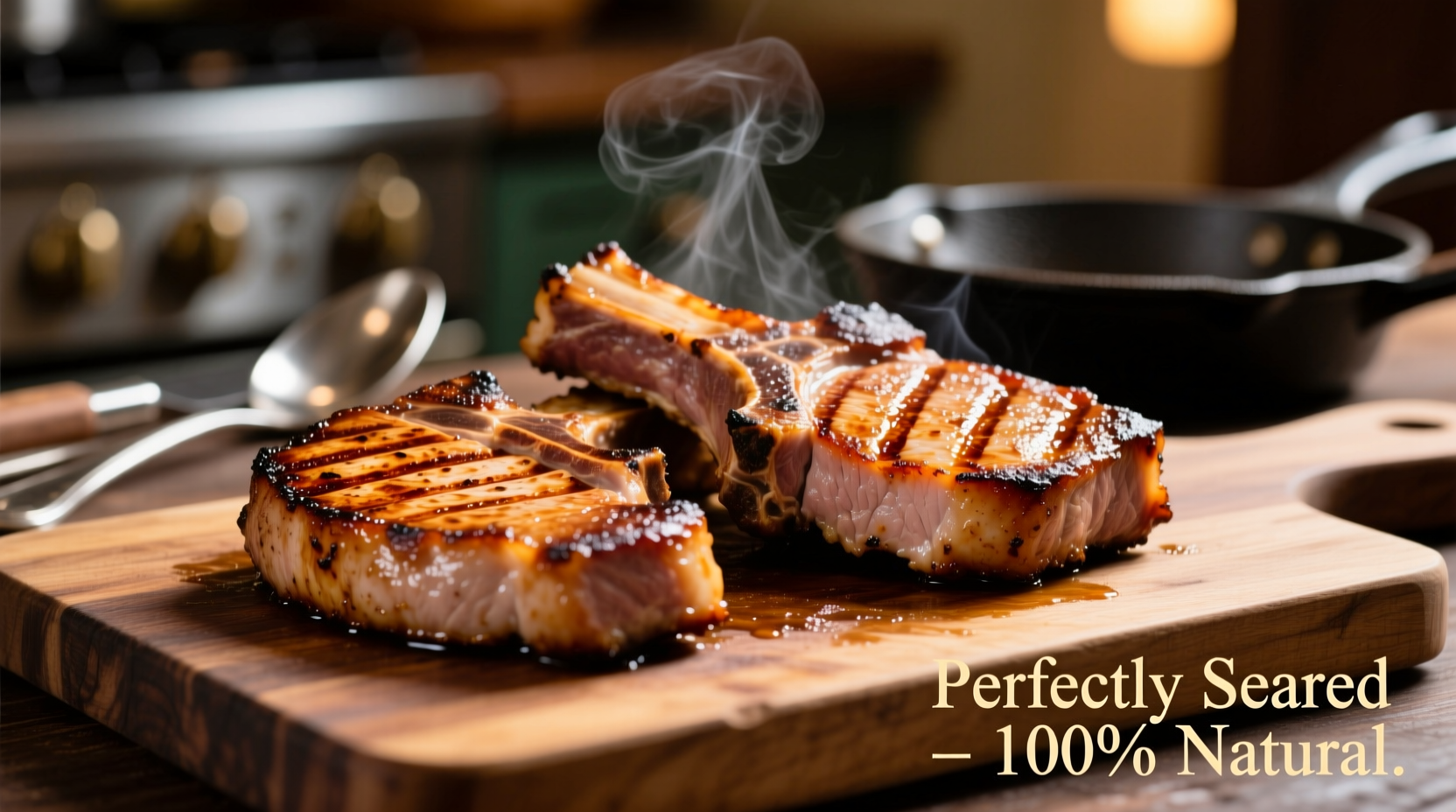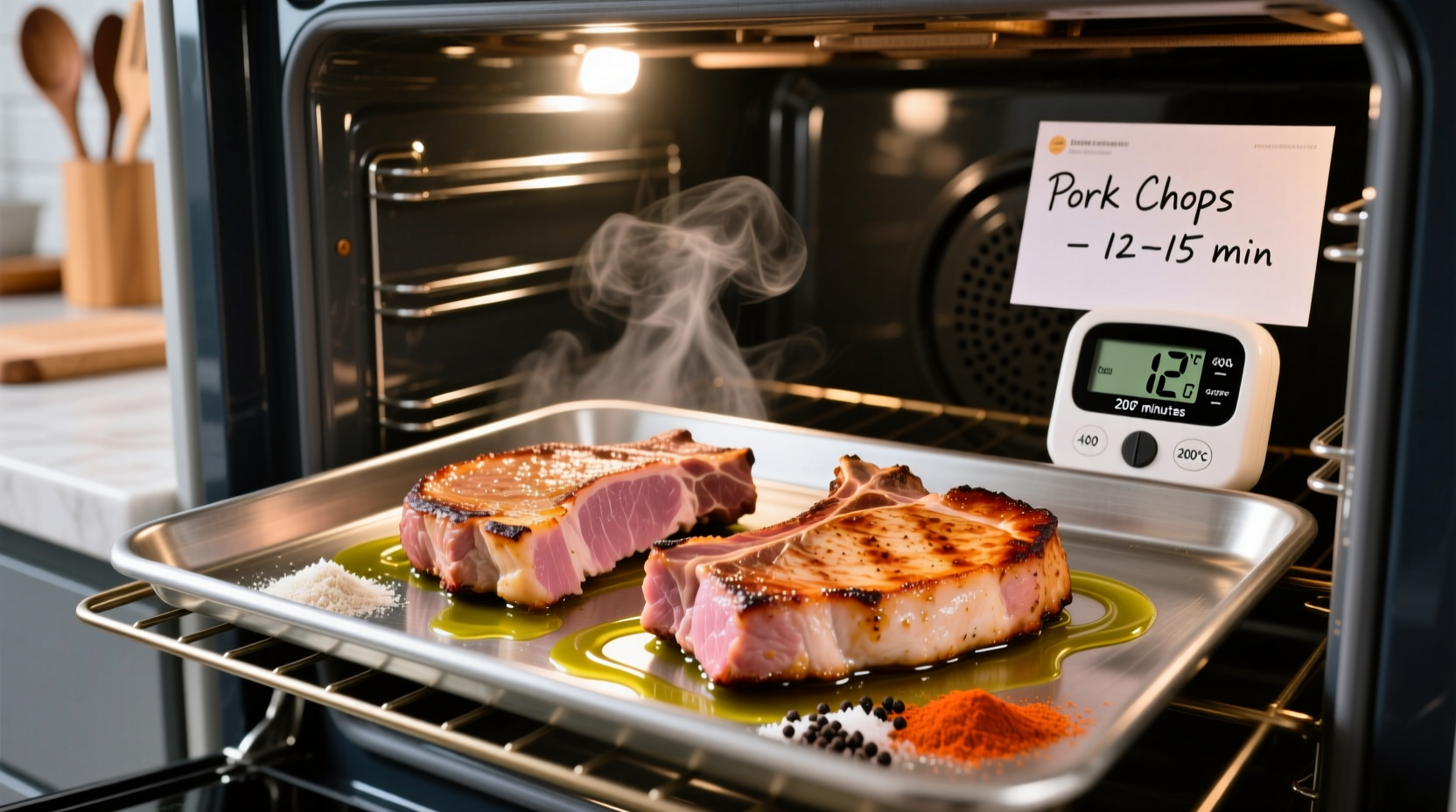Getting oven-baked pork chops perfectly cooked can transform your weeknight dinner from dry disappointment to restaurant-quality success. As a culinary professional who's tested hundreds of pork chop preparations across different kitchen environments, I've discovered that timing isn't just about minutes on the clock—it's understanding how multiple factors interact to create that ideal juicy-but-safe result. In this guide, you'll learn the exact cooking times based on thickness, plus professional techniques that guarantee perfect pork chops regardless of your oven's quirks.
Why Timing Matters: The Science Behind Perfect Pork Chops
Unlike older cooking guidelines that recommended cooking pork to 160°F, modern food safety standards from the USDA now confirm that 145°F with a 3-minute rest is both safe and optimal for juiciness. This temperature allows the meat proteins to denature properly without squeezing out all moisture—a critical balance that separates succulent pork from dry disappointment.
Key Factors That Change Your Cooking Time
Before you preheat your oven, understand these four variables that significantly impact how long your pork chops need in the oven:
- Thickness matters most—a 1.5-inch chop needs nearly twice as long as a ¼-inch cutlet
- Starting temperature—chops straight from the fridge need 3-5 extra minutes versus room-temperature meat
- Oven accuracy—most home ovens vary by ±25°F, making a thermometer essential
- Bone presence—bone-in chops cook slightly slower due to the bone's insulating effect
The Complete Oven-Baked Pork Chop Method
Preparation: Setting Up for Success
Dry your chops thoroughly with paper towels—moisture is the enemy of proper browning. Season generously with salt at least 45 minutes before cooking (or immediately before if short on time), as this helps develop flavor and texture. For best results, bring chops to room temperature for 30 minutes before baking, but never leave them out longer than 2 hours for food safety.

Optimal Oven Settings and Timing
Preheat your oven to 400°F (200°C) with the rack positioned in the center. Place chops on a wire rack over a baking sheet for even air circulation. Here's the precise timing based on thickness:
| Pork Chop Thickness | Oven Temperature | Approximate Cooking Time | Target Internal Temp |
|---|---|---|---|
| ¼ inch (thin-cut) | 400°F (200°C) | 8-10 minutes | 140°F (60°C) |
| ½ inch | 400°F (200°C) | 10-12 minutes | 140°F (60°C) |
| 1 inch (standard) | 400°F (200°C) | 15-20 minutes | 145°F (63°C) |
| 1.5 inches (thick-cut) | 375°F (190°C) | 22-28 minutes | 145°F (63°C) |
Important note: These times assume chops start at room temperature. Add 3-5 minutes if cooking straight from the refrigerator. Always verify with an instant-read thermometer rather than relying solely on time.
The Critical Resting Phase
Remove chops from the oven when they reach 140-142°F for standard thickness cuts. During the mandatory 3-minute rest (as confirmed by USDA Food Safety guidelines), carryover cooking will raise the temperature to the safe 145°F mark while allowing juices to redistribute. Cutting too soon releases precious moisture onto your cutting board instead of staying in the meat.
Pro Techniques for Foolproof Results
Professional kitchens use these methods to ensure consistent quality:
- The reverse sear method for thick chops: Start at 275°F until internal temperature reaches 120°F, then finish under the broiler for 2-3 minutes for perfect crust
- Brining for insurance: A 30-minute soak in 4 cups water with ¼ cup salt adds moisture buffer for beginners
- Oven thermometer verification: Calibrate your oven with a standalone thermometer—most home ovens are inaccurate by 25°F or more
Troubleshooting Common Issues
When Pork Chops Turn Out Dry
If your chops consistently turn out dry despite following timing guidelines, check these three culprits:
- Overcooking by just 5°F—pork's lean nature means the difference between perfect and dry is minimal
- Skipping the rest period—those 3 minutes make a measurable difference in juiciness
- Poor oven temperature control—invest in an oven thermometer for $10
Handling Different Oven Types
Convection ovens cook approximately 25% faster than conventional ovens. Reduce cooking time by 5-7 minutes or lower the temperature by 25°F when using convection settings. For older ovens with hot spots, rotate the baking sheet halfway through cooking for even results.
Expert Tips for Flavor Enhancement
While timing ensures proper doneness, these techniques elevate flavor:
- Pat chops dry again right before seasoning—surface moisture prevents proper browning
- Add aromatics to the pan: fresh rosemary, garlic cloves, and lemon slices infuse subtle flavors
- Finish with a compound butter—chef's secret for instant restaurant-quality flavor
- For crispy edges, start with a quick stovetop sear before transferring to the oven
Food Safety Verification
The USDA Food Safety and Inspection Service confirms that cooking pork to 145°F with a 3-minute rest is microbiologically safe, eliminating previous concerns about trichinosis. This standard, established in 2011 and reaffirmed in subsequent reviews, represents the perfect balance between food safety and quality. Always use a calibrated instant-read thermometer for verification—color alone is unreliable for determining doneness in pork.
FAQ: Oven-Baked Pork Chop Questions Answered
How long to cook 1.5-inch thick pork chops in the oven?
Thick 1.5-inch pork chops need 22-28 minutes at 375°F (190°C). Use the reverse sear method for best results: cook at 275°F until internal temperature reaches 120°F, then finish under the broiler for 2-3 minutes to develop crust.
Can you cook frozen pork chops in the oven?
Yes, but add 50% more cooking time and start at 350°F (175°C). Place frozen chops directly in the oven without thawing. Check temperature 10 minutes before expected finish time. Never cook frozen pork chops at high temperatures as the outside will burn before the inside cooks through.
How do you know when pork chops are done without a thermometer?
Without a thermometer, use the touch test: properly cooked pork should feel firm but slightly springy, similar to the fleshy part of your palm below the thumb when your hand is relaxed. The juices should run clear, not pink. However, an instant-read thermometer is strongly recommended as visual cues can be unreliable.
Should you cover pork chops when baking in the oven?
No, never cover pork chops while baking. Covering creates steam that prevents proper browning and can make the exterior soggy. For best results, place chops on a wire rack to allow air circulation around all sides. If concerned about drying, use a lower temperature rather than covering.
Why are my oven-baked pork chops tough?
Tough pork chops usually result from overcooking or improper resting. Pork's lean composition means it dries out quickly past 145°F. Additionally, skipping the 3-minute rest period prevents juices from redistributing. For tough chops, slice very thinly against the grain and serve with a flavorful sauce to add moisture.











 浙公网安备
33010002000092号
浙公网安备
33010002000092号 浙B2-20120091-4
浙B2-20120091-4